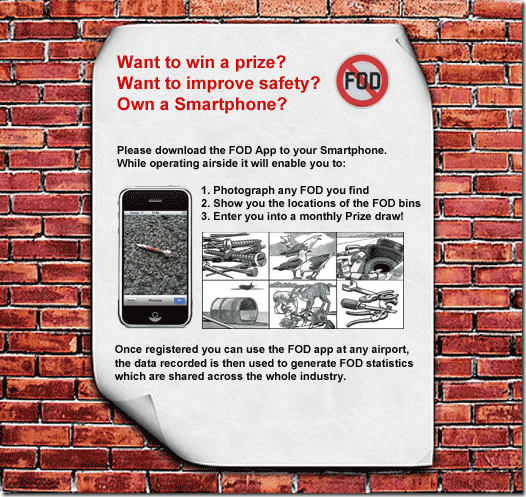
…well, there isn’t, but I firmly believe there should be.
I’ve just read through the new FAA draft Circular on FOD Management, and it discusses the fact that it’s the responsibility of everyone to report FOD if they come across it. I believe that if you want people to do something, especially if it’s not their main role, you have to:
- make the function quick and easy to perform, and
- offer an incentive.
And let’s get one thing straight, asking a contractor who’s working airside to visit an office on the far side of the airfield to locate and complete a FOD reporting form does neither of these, it’s definitely not quick, and there’s no incentive. Actually it’s more likely to get them into trouble with their boss as they’d have to explain why they’d not been doing their job for the last 30 minutes!
The first thing you have to do is to give the person who found the FOD a method of recording the event then and there, because if they plan to leave it until the end of their shift then it’s not going to get done at all, and I’m not talking about a new device for them to carry around all day, because they won’t carry it. You have to take advantage of the fact that it’s very likely that they’re carrying a small recording device with them anyway, and yes, if you haven’t already guessed from the mock poster above, I’m talking about a smartphone.
There are 3 reasons why smartphones are perfect for recording FOD finds:
- they have cameras
- they have GPS
- they can transmit data
The apps function would be very simple with the help of mobile testing services, take a picture of the FOD, select a category (wildlife, tools etc), and assign a risk (low, medium, high), that’s it. The image would be tagged with the location via GPS,and the data would then be sent to a central database. Once the FOD find has been recorded, the app could then give the location of the nearest FOD bin, or supply the phone number of the FOD manager.
Provide an incentive
Even if something is quick and easy to do people still need an incentive to do it. If the user who downloads the app also has to register, then any FOD finds they record will be registered against them, and then it’s simply a case of offering some form of reward, e.g. entry into a monthly prize draw. The more FOD they record the more likely they are to win.
Make it global
One of the advantages of this concept is that once a user has downloaded the app and registered as a user, it could be used on any airfield in the world, the GPS data would be all that’s required to identify the airfield, and this location information would then supply custom information back to the user i.e. the phone number of the FOD manager and the location of the FOD bins (or any FOD procedures that are unique to the airfield)
It’s all about the sharing
Where would all this FOD information go? I would strongly suggest to a single, centrally (FAA?) managed database. Airports could be given access via a website to the data collected from 100’s of airports, this data could then be used to generate better targeted FOD procedures.
If you have any thoughts on this concept then please leave a comment in the comments section below, or get in touch via the contact form.






